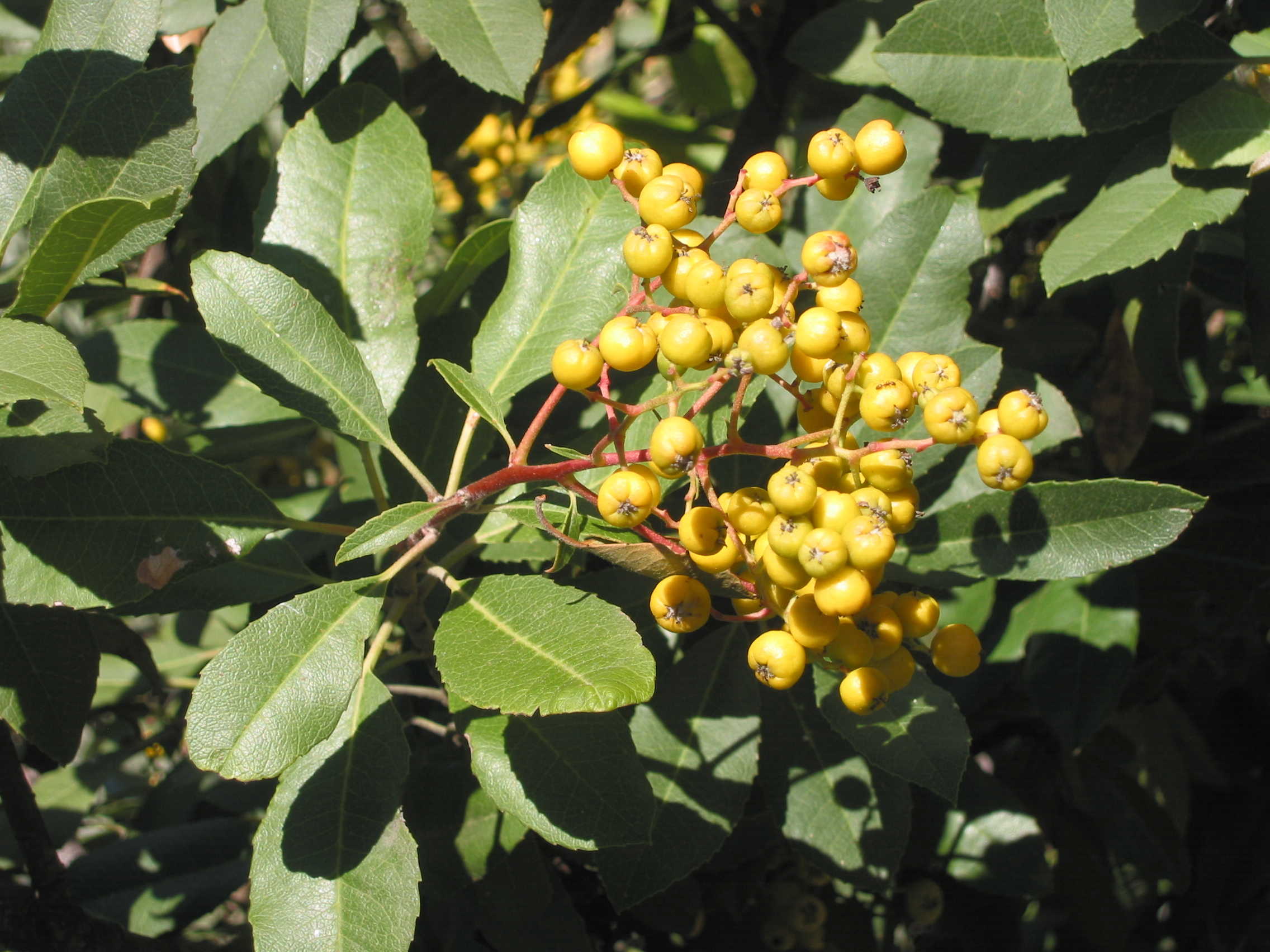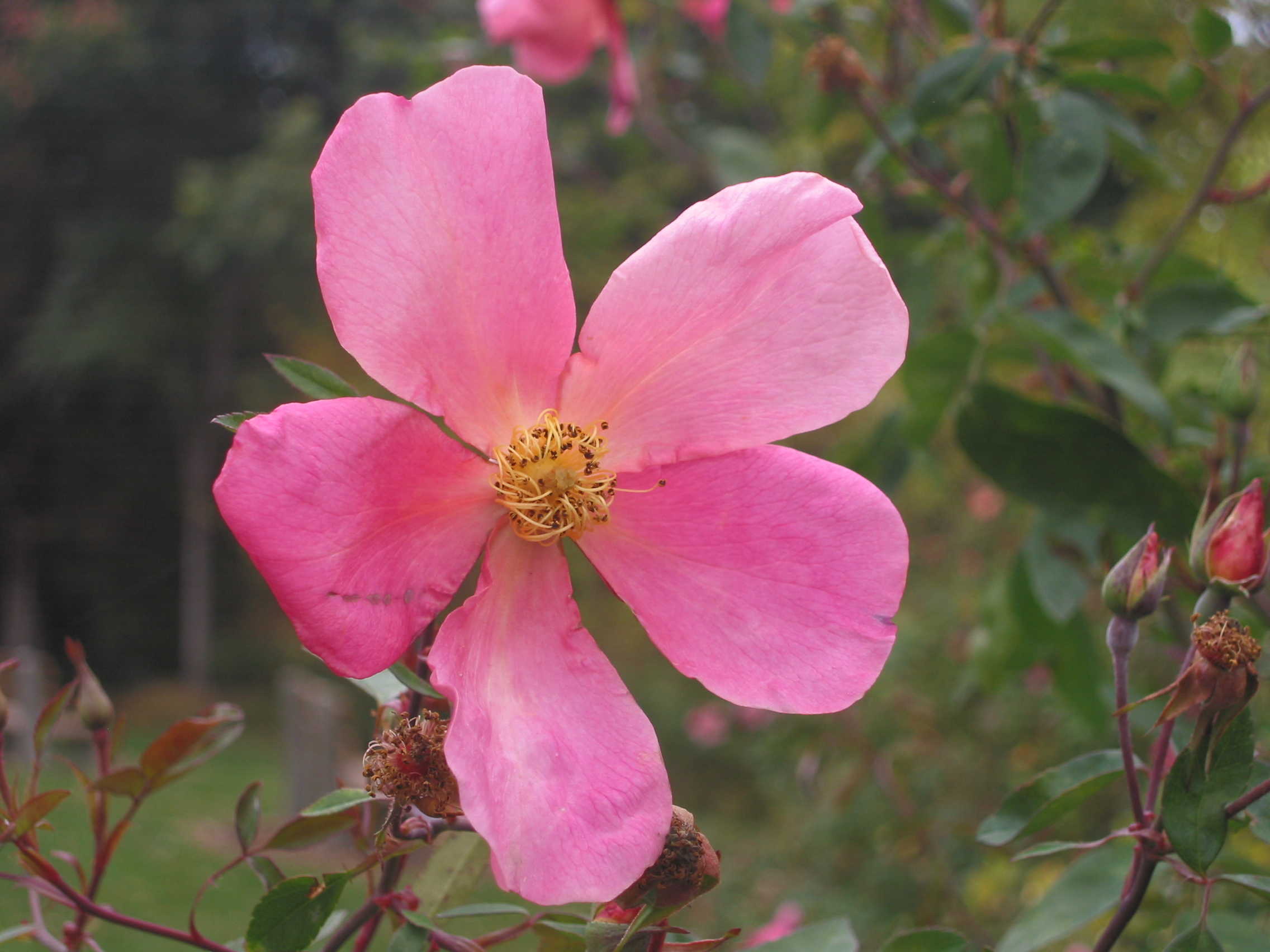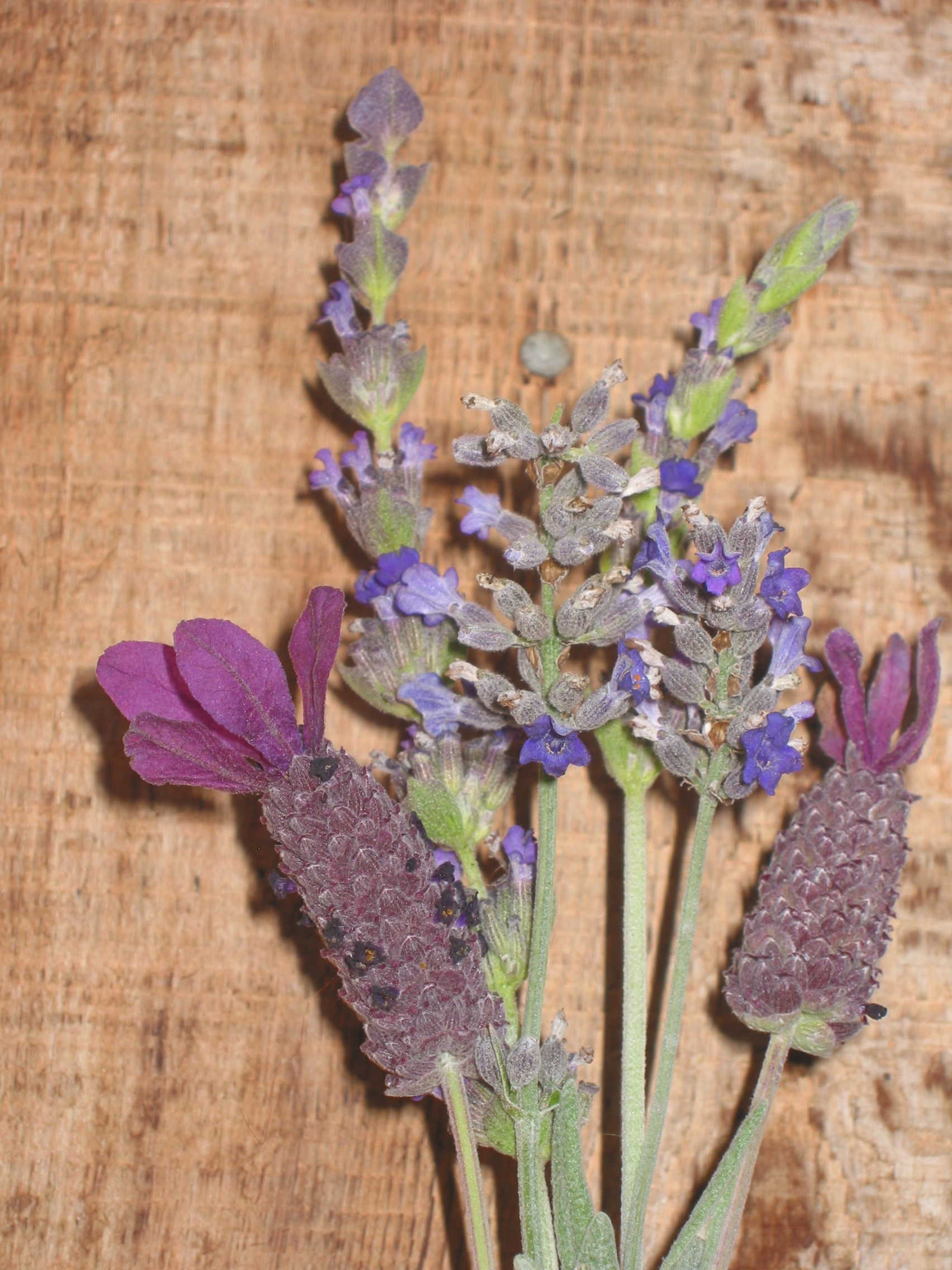About the Arboretum All-Stars
written for the Davis Enterprise, December 03, 2009
If you're looking for ideas in the "off" gardening seasons - the heat of summer or the waning days of fall - a walk in the arboretum can be helpful. On a sparkling November day I parked near Mrak Hall and wandered east toward the redwood grove, making note of what had seasonal color or interest.
Before you even enter the arboretum you can see a plant unique to Davis. Toyon (Heteromeles arbutifolia) is a native shrub whose abundant berries are turning bright red now. Their winter color leads to a second common name: California Christmasberry. A number of years ago a yellow-fruited variant occurred, and a nice specimen is growing just at the corner of Old Davis Road where you turn in towards Mrak Hall. This variety is now called 'Davis Gold'. While you might think a yellow berry would be less interesting than the seasonal red of the traditional species, I noted that the lighter-colored fruit stands out better against the dark green foliage.
 Toyon (Heteromeles arbutifolia) is sometimes called California Christmasberry
Toyon (Heteromeles arbutifolia) is sometimes called California Christmasberry
 Toyon (Heteromeles arbutifolia) is a popular native shrub that grows slowly to 10' or more, with flowers that attract beneficial insects and winter berries that attract songbirds. The species, shown at left, typically has red berries, but this golden-fruited variety called 'Davis Gold' originated right here at the UC Davis Arboretum. Check their sales for availability, as it is uncommon in the trade.
Toyon (Heteromeles arbutifolia) is a popular native shrub that grows slowly to 10' or more, with flowers that attract beneficial insects and winter berries that attract songbirds. The species, shown at left, typically has red berries, but this golden-fruited variety called 'Davis Gold' originated right here at the UC Davis Arboretum. Check their sales for availability, as it is uncommon in the trade.
There were some very early blooms on the winter currants (Ribes), and a stray California poppy (Eschscholzia californica) was peeking out. Both are really winter and spring bloomers, and there was not much else going on in the California Native Plant garden, except, of course, the tree squirrels scampering everywhere.
A flash of color around on the west side of Putah Creek drew my eye. Rosa chinensis 'Mutabilis' is a very robust old China rose that has a unique quality: the blossoms open light apricot-yellow, then (contrary to most flowers) darken as they age through pink to red (hence the name "mutabilis"). The blossoms are a single row of papery petals, usually twisted and splayed. With upright petals in all colors, all on the plant at the same time, it has sometimes been called the Butterfly rose because it looks as though dozens of butterflies have alighted on the bush.
 The Butterfly rose is usually listed in references as Rosa chinensis 'Mutabilis', but the Arboretum All-Star list now has it under the name R. x odorata 'Mutabilis'. The delicate-looking flowers consist of a single row of petals which open yellow, then darken through pink to red. Dozens of blooms are open on the plant at a time, from April through November.
The Butterfly rose is usually listed in references as Rosa chinensis 'Mutabilis', but the Arboretum All-Star list now has it under the name R. x odorata 'Mutabilis'. The delicate-looking flowers consist of a single row of petals which open yellow, then darken through pink to red. Dozens of blooms are open on the plant at a time, from April through November.
This is a large shrub! It can reach a height of 7 - 8' tall with equal spread.
Roses in November? Sure. Northern California gardeners often enjoy a last flush of bloom on rose bushes even as they begin to go dormant. Some will set a crop of colorful hips as well; the rose hip is just the fruit of the bush.
Toyon, currants, and the Butterfly rose have one thing in common: they are all on the list of Arboretum All-Stars. (I notice that Rosa x odorata 'Mutabilis' is the currently accepted name of the Butterfly rose used on the All-Star list, but nearly every other reference is likely to have it by the older name I used above. Someday I will write a column about why taxonomists change plant names.)
A few years ago the staff at the arboretum began compiling a list of plants that do well in the Sacramento Valley. The stated basis for selection as an All-Star:
"100 tough, reliable plants that have been tested in the Arboretum, are easy to grow, don't need a lot of water, have few problems with pests or diseases, and have outstanding qualities in the garden. Many of them are California native plants and support native birds and insects. ... The vast majority of All-Star plants can also be successfully planted and grown throughout California."
I love this list, but frankly it is beginning to drive retailers and landscapers a little crazy. Not because of the list itself or the plants on it, but because of public misconceptions about it. It is not intended as a definitive list for the region, and availability can be a problem.
If I were making any criticisms, it would be that some of the plants are easy to kill: winter daphne, and natives such as ceanothus, manzanita, and western redbud are all notoriously easy to over-water. Some plants tolerate drought while others require it; many California natives are vulnerable to crown rot fungus caused by summer watering. The list is light on trees, and those selected are mostly unavailable in the nursery trade (perhaps their inclusion here will interest some wholesale growers in propagating them). But those are minor concerns, and I have been told that another 50 or so recommendations are on their way.
What it is:
An excellent list of many plants that do well in our area.
A great starting point as you select plants for your landscape design. With two ferns, seven grasses, 35 perennials, 42 shrubs, 8 trees, 6 vines, you can find ideas for a new landscape or a renovation project. One-third of them are California natives. Many are unusual, perhaps helping you think outside of the traditional options.
What it is not:
It is not an availability list!
This is probably the biggest problem for retailers and landscape designers. Many of these plants are uncommon in the trade. A couple of times I have sat down with the entire All-Star list to check it against availability lists from the growers I do business with. Recent results were similar to what I found in the spring:
44 of the 100 All-Stars were readily available. Not bad!
25 had been on an availability list within the last few months; i.e., sometimes available. If you order it, be patient.
There were 24 that I have seen on an availability list at some point within the last couple of years, but not recently; i.e., uncommon. Consider alternatives!
7 are simply not in the trade from any Northern California grower that I am aware of; i.e., unavailable. Join the arboretum and browse their sales!
It will be rare for any nursery to have more than a small percentage of these plants at any given time. Plant availability changes from week to week in the wholesale nursery industry. Retail nurseries juggle orders each week, based on the minimum required by the grower, special orders, what's selling, and seasonal traffic. Some of these plants don't exactly sell themselves in the nursery container (ever seen a Crinodendron patagua? It's kind of scruffy looking).
Retailers do not buy from the arboretum.
Propagation stock of some of the All-Stars, along with marketing materials, has been provided to four wholesale growers. Wholesalers generally do not sell directly to the public. One Sacramento-area wholesaler, High Ranch Nursery, does sell the plants through their online store. Many other growers already produce some, so a nursery that is willing to special order plants may be able to obtain them.
For those that are uncommon or unavailable at retailers, there may be mail order sources: ForestFarm in Oregon (www.forestfarm.com) is a grower with an amazing selection of shrubs, trees, and perennials. Or visit the arboretum plant sales (you can always join at the door).
It is not a list of THE best plants for the Sacramento Valley.
Exclusion of a variety - say, of a particular lavender or ornamental sage - does not indicate that it is not suitable. In some cases there are just too darn many to choose among. Sometimes a newer variety is available that you may wish to consider.
Take perennials, for instance. I have a database of perennial plants from various wholesale growers that includes over 1300 species and varieties. I would have trouble narrowing down that list to 35 of the "best" for this area! Those on the All-Star list are suggestions, but don't hesitate to consider related types.
For example, the list includes the Spanish lavender (Lavandula stoechas) variety called 'Otto Quast', and a hybrid called 'Goodwin Creek' (reportedly a cross between two species). Each is excellent in its own way. But there are 3 - 4 dozen varieties of lavender in the trade, including true English lavenders, hybrid lavandins, French lavender, and many more, varying considerably in height and spread, leaf texture, and fragrance of flowers and leaves. All are drought tolerant and nearly all are excellent for Valley gardens.
 A mix of lavenders:
A mix of lavenders:
'Wings of Night', on the left and right, is a Spanish lavender with a group of showy petals clustered toward the top of the inflorescence. Like the All-Star variety 'Otto Quast', it has a reasonably compact growth habit and a long blooming season, but the fragrance of spanish lavenders is an acquired taste.
'Goodwin Creek' and 'du Provence', the taller and shorter center flowers respectively, have more pleasant "true" lavender scent on larger plants.
What is your priority with lavender? The Spanish forms have tighter growth habits in the garden, and a somewhat longer bloom season. 'Wings of Night' is a newer variant of Spanish lavender that is equally tough and is said to have an even more compact growth habit than the All-Star 'Otto Quast'. But if you want fragrance, consider the All-Star variety 'Goodwin Creek', or the especially fragrant varieties 'du Provence' and 'Grosso'. In a recent sniff comparison, staff commented about 'Goodwin Creek' that it was "musky, like true lavender" and 'du Provence' was "sweet, lemony." Spanish lavender? "Phew, yuck, smells like turpentine!" Perhaps a more neutral descriptor would be "resinous."
Where you can see them, where you can buy them.
In the Arboretum the All-Stars are often identified with bright, colorful signage. Some have metal tags with the All-Star logo.
On-line references include an excellent web site of one of the wholesale growers, Native Sons Nursery: http://nativeson.com. This nursery, which does not sell to the public, is located in Arroyo Grande, just south of San Luis Obispo in Southern California, so you aren't going to see their trucks up here very often. But they have great pictures of the All-Stars.
Hit or miss, this is a great list for gardeners and designers. We look forward to the expansion of the list, and to greater availability of these plants.
For more information, visit the Arboretum web site at http://arboretum.ucdavis.edu
Click here for articles about Lavenders and Salvias
© 2009 Don Shor, Redwood Barn Nursery, Inc., 1607 Fifth Street, Davis, Ca 95616
www.redwoodbarn.com
Feel free to copy and distribute this article with attribution to this author.
Click here for Don's other Davis Enterprise articles
